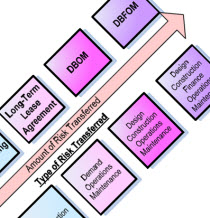Public-Private Partnerships Strategy Paper
Public-Private Partnerships Strategy Summary
 The decision to authorize the use of Public-Private Partnerships (PPPs) rests with individual states. Currently, approximately 24 states have significant PPP authority, which can include the ability to: enter into "design-build" contracts; accept and respond to unsolicited proposals from the private sector; or, take advantage of innovative Federal financing programs (like the SEP-15 program, or TIFIA). While Illinois does not have the legal authority to enter into PPP agreements, or to establish quasi-public or non-profit entities to enter into agreements, individual cities and municipalities may still pursue these types of financing arrangements with virtually no state involvement.
The decision to authorize the use of Public-Private Partnerships (PPPs) rests with individual states. Currently, approximately 24 states have significant PPP authority, which can include the ability to: enter into "design-build" contracts; accept and respond to unsolicited proposals from the private sector; or, take advantage of innovative Federal financing programs (like the SEP-15 program, or TIFIA). While Illinois does not have the legal authority to enter into PPP agreements, or to establish quasi-public or non-profit entities to enter into agreements, individual cities and municipalities may still pursue these types of financing arrangements with virtually no state involvement.
Table of Contents
- Overview
- Legal Boundaries
- Scope of Paper
- Types of PPPs
- Synthesis
- CMAP relevance
- Issues and options
- Recommendations
- Further Research
- Appendix
This paper includes the common definition of different PPP types, their strengths and weaknesses from the MPO perspective, and sample projects of each type.
If you're interested in learning more about public-private partnerships, please review the following strategy report, prepared by the Volpe Center for CMAP. Comments and criticisms are encouraged.
A sample of findings:
- While the state of Illinois does not currently have the authority to enter into PPP arrangements, individual cities and municipalities may still pursue these types of fiinancing arrangements
- CMAP can play a key role in assisting local governments in performing a more comprehensive value for money analysis
- PPPs can serve to accelerate delivery time, reduce costs, and improve construction and design quality but there are often controversial risks involved
|
|